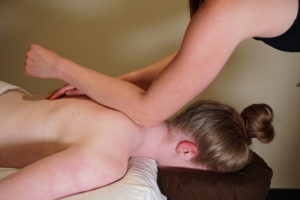Deep Tissue Massage targets the deep tissue structure of the fascia and muscles, referred to as connective tissue. Of the many types of massage, deep tissue focuses on the release of muscle tension and chronic knots, trigger points, and adhesions.
All of our massage therapists can perform deep tissue massage as well as firm or deep pressure massage. However, please be sure to mention you are scheduling a deep tissue massage to ensure we pair you with the right massage therapist.

Benefits of Deep Tissue Massage
- Relieves pain
- Reduces emotional stress
- Enhances mood
- Increases range of motion
- Aids respiratory functioning
- Improves circulation
- Boosts immunity
What Does It Do?
Deep tissue massage can break up and eliminate scar tissue from previous injuries. A common problem is that stressed muscles can block nutrients and oxygen from getting to where they need to go, and this will cause inflammation that allows toxins to build up in your muscle tissue. The inflammation and toxins contribute to pain and stress.
Deep Massage breaks up and releases the built-up toxins by loosening the muscles. With the toxins released, blood and oxygen can circulate as they should through one’s body. Being properly hydrated before you go to your massage appointment and drinking plenty of water after one of these massages is highly recommended. This is especially important because deep massage can cause post-session tiredness or “massage brain”. Make sure to rehydrate yourself before you go to sleep post-session! You may hurt in the morning, but there is a difference between “therapeutic pain” and weighty dehydrated pain.
What Techniques Are Used in Deep Tissue Massage?
The strokes used are similar to those used in a Swedish Massage except more pressure is used and it uses cross grain strokes (strokes that go across the grain of the muscles instead of with the grain). Deep tissue massage starts with addressing the deeper layers of muscle in order break up adhesions from the bottom to the top, whereas Swedish massage starts with the palpating the more superficial muscles to promote relaxation. As with a classic Swedish massage, you will be lying naked on a massage table and partially covered with a sheet or towel.
During Swedish massage, usually the therapist will only use their hand and forearm, however with a Deep Tissue Massage, elbows, fingers, and ceramic, wooden, or glass tools may be used for optimal penetration of the muscle. The speed of the strokes will be slower than a classic massage as well, which means they are longer in duration (about an hour and a half, depending on the therapist and how much you pay). If you tell the therapist where your trouble spots are (everyone has one or two) before the massage starts, during the massage the therapist will apply pressure and hold it for a few minutes before moving on, for extra relief.
What Should I Expect During a Deep Tissue Massage?
Many massage therapists have some basic deep tissue training, so they can do some of the techniques during a classic massage. However, for a good Deep Tissue Massage you should find a massage therapist that specializes in it. There may be some soreness after a deep tissue massage; however, the soreness should go away within a day or two. The massage itself should not hurt but will be a little more uncomfortable than a classic massage. If you feel the pressure is too hard, tell the masseur. Do not act tough if the massage causes severe pain or the pressure is too hard, as it may do more damage than restoration. The knots in your muscles won’t release unless they can relax; if you allow your body to tense up during the session, you may defeat the purpose of the massage.
Some people think that if you just push hard enough, a knot could be worked out in one session, but this is not the case. For built-up tension and chronic knots (adhesions) deep tissue massage is just one part of the treatment. If you do not exercise, correct your posture, and/or employ relaxation techniques along with Deep Massage you may not get the full benefits from your massage.
Don’t Forget to Breathe During Your Massage!
One of the most important things to remember to do when getting a Deep Tissue Massage is to breathe deeply during the session and while relaxing afterwards. Oxygenating the muscles will help the massage do its work and ease discomfort. Be sure to ask your massage therapist what you can do post-massage to optimize the your healing process after the session.
Our Award-Winning Signature Massage is our most popular choice. It's a customized blend of massage techniques to boost well-being, alleviate pain, tension, and stress. Whether you need targeted relief or a full-body relaxation, this massage has you covered.
Signature Massage Rates Include: Deep Tissue, Swedish, Sports, Trigger Point Therapy, Cupping, Foot Focus, Reflexology, and Pediatric.
Upgrade any massage to a CBD Massage for $15.
*Pediatric massage rates are at VIP Member pricing.
Full Price |
VIP Member Price |
|
| 30 min Signature Massage | $80 | $55 |
| 60 min Signature Massage | $125 | $90 |
| 90 min Signature Massage | $170 | $125 |
| 120 min Signature Massage | $215 | $160 |
*Very Important: At the time of booking, please discuss the type of massage or other service you are expecting when you schedule your appointment. This will ensure we match you with the most appropriate staff member for your needs.
We require a Credit Card on file to schedule any appointment at MTW. If you need to reschedule, please notify the office at least 24 hours prior to your appointment start time to avoid the Late Cancellation Fee. When possible, our massage therapists prefer to receive cash tips or tips through Venmo.
